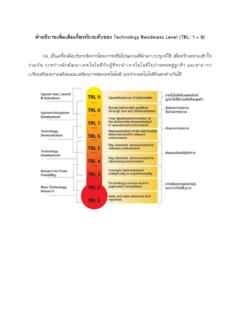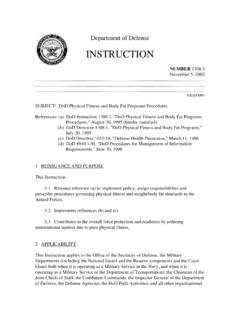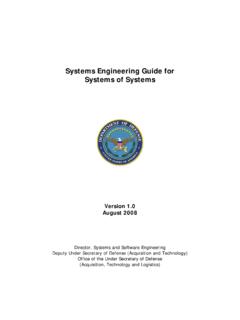Transcription of Principles and Strategies of a Successful TVET Program
1 October 2010 Principles AND Strategies OF A Successful TVET Program ACKNOWLEDGEMENTSP rinciples and Strategies of a Successful TVET Program The Institute is very grateful to various staff that provided input, improving the document. Their participation has enhanced the value of the information for elected officials, policy makers, NGO,s, international donors and Program con-tractors. We also extend thanks to the various MTC Executive staff who contributed their understanding and knowledge to the project. Finally, we recognize the valuable guidance and feedback of this project from Roberts T. Jones, Presi dent, MTC Institute as well as comments and observations from Jill Elkins, Director, International Development and MTC Vice Chairman of the Board, Jane Marquardt, whose input helped make this document by MTC Institute. Copyright October 2010 Principal Authors: Stephen MacDonald, Carl Nink, and Stephen DugganComments are appreciated and should be directed to Carl Nink, Executive Director at:MTC Institute 500 North Marketplace Drive Box 10 Centerville, UT 84014 (801) 693-2870 Fax: (801) 693-2900 & Training Corporation (MTC) is an international corporation dedicated to helping people realize their learning potential.
2 MTC creates nurturing environments in which education is encouraged and rehabilitation is recog-nized. MTC manages and operates 24 Job Corps centers in 19 states for the Department of Labor, preparing disad-vantaged youth for meaningful careers. MTC also operates 18 contracted correctional facilities across the US with ap-proximately 24,000 beds under contract. In addition, MTC has expanded its education and vocational expertise into the international arena, working in countries such as Iraq, Sudan, Mongolia, Jordan, and Palestine. The MTC Institute is the research division of MTC, which is dedicated to promoting innovations and exemplary practices and projecting trends that are relevant to job training and corrections. The work of the Institute is geared toward a broad audience including policy makers, educators, researchers, practitioners, state and federal officials, workforce development entities, correc-tional agencies, Job Corps centers, international donors and operators.
3 Principles and Strategies of a Successful TVET Program Management & Training Corporation 1 INTRODUCTIONAs the world emerges from the current economic downturn, the ability of a country to increase the skills of its workforce is a significant concern to business and government. The need to increase employment opportuni-ties and to enhance the workforce s social mobility through improved employability is particularly pressing in those countries where a full school education followed by university may not lead to employment. Recovery from the latest economic meltdown is not being evenly experienced globally, but there are some troubling consistencies. Some of the consistencies include an ever apparent youth bulge as youth unsuccessfully seek entry to formal employment, and an ever increas-ing expansion of the 15-30 year old group (in terms of the total workforce population) has not provided the fuel for reducing a global skills shortage.
4 As the global demand for skilled workers has strengthened, the capacity of national economies to meet that demand has declined. This is particularly true given these important facts: An extra one billion people in the world will become of working age within the next decade1, Those 15 to 25 years of age in developing countries represent 85% of the world s population2, and Conservatively, 89 million more secondary training places are needed by 20153. In response to the growing demand and need for skilled labor and tech-nicians across a wide range of sectors, a comprehensive, up-to-date, and effective Technical and Vocational Educational and Training (TVET) Program is essential to a country s effort to:4 Expand levels of education and training cooperation between public and private sector employers, Increase productivity, Reduce poverty through comprehensive and productive activities, Build trade capacity, and Further develop priority sectors including energy and the environ-ment.
5 Collectively, an approach that increases employment, improves employ-ability and social mobility, and stimulates trade and commerce will steadily reduce poverty and improve both personal and national income is well recognized that the development or re-development of a relevant market and responsive TVET system is not an exact science. Histori-cally, different countries, particularly those with a strong industry base and infrastructure, have articulated quite distinct TVET systems. In some countries, higher education and TVET are structured as a dual-sector with an overarching national qualifications and training framework. In other countries, TVET is quite separate from the formal school education system and is often regarded as a deficit system that leads to poorer employment opportunities and low income. Indeed, in some countries, former Soviet economies for instance, TVET teachers are paid more poorly than primary school teachers and TVET colleges are in a poor state of readiness with An extra one billion people in the world will become of working age within the next decadeConservatively, 89 million more sec-ondary training places are needed by 2015 Principles and Strategies of a Successful TVET Program 2 Management & Training Corporation tools and equipment well past their usefulness.
6 While some TVET systems are complex, dynamic and heavily driven by private sector/industry en-gagement, such systems may not easily be Others are poorly developed, fragmented, and unresponsive to employment demand and should not be is generally agreed that a modern and responsive TVET system needs to take into account current and expected socio-economic conditions including labor market demand, the needs of both the formal and informal sector in relation to employment, and the professional capacity of TVET teachers and Further, TVET must attend to the specific em-ployment needs of both rural and urban situations and take account of belief and value systems, religions and customs, and different (particularly in relation to gender and social dimensions in training and employment) regional and indeed climatic variations between regions within a & Training Corporation (MTC) has learned, as have most in-ternational TVET contractors, through our experiences working in the and diverse countries such as Iraq, Sudan, Mongolia, Jordan, Palestine, that it is crucial to make careful distinction about the structure and function of TVET.
7 This holds especially true as more developing countries consider adopting or adapting TVET reforms, particularly when borrowing ap-proaches to TVET from other countries. This includes an appreciation of uneven levels of numeracy and literacy and interestingly, the quality of the national government and education recognizes that a TVET system that works well in Indonesia may not work as well in Zambia. Since each country and economic situation is different, it is important to search, identify, define, and apply what can be considered the basic Principles of an effective TVET system. The top six (6) Principles inherent in a Successful TVET system are:7 Relevance to the labor market (one that meets employer s needs and expectations), Access for trainees, Quality of delivery, Standardization, Inclusion of soft skills, and Funding for the system is secure and country or regional contextualized and customized approach to TVET is best as it permits one to validate skill sets and adjust the approach of learning as it best fits the country or Principles OF A Successful TVET SYSTEM 1.
8 Relevance to the Labor Market: An effective Technical and Vocational Education and Training system within a country is a critical pillar of any Successful economy. It can serve as the impetus to boost the value of the nation and it s GDP in the global marketplace. Effective TVET also rec-ognizes that education and training in any country needs to be based on reliable labor market information and demand and employer needs, par-ticularly in priority trades and occupations. TVET must attend to the specific employment needs of both rural and urban situations and take ac-count of belief and value systems, religions and customs, and different (particularly in relation to gender and social dimensions in training and employment) regional and indeed climatic variations between regions within a and Strategies of a Successful TVET Program Management & Training Corporation 3To illustrate, this is the focus of the partnership between Korea s Samsung Corporation and the Korea University of technology (KUT).
9 In 2005, the KUT established a KUT-Samsung Electronics High- technology Education Center (KSHEC) in cooperation with Samsung for the purpose of human resource development and human talent management through high-tech-nology education. A key task of KSHEC is to develop and launch programs for job skills training including high- technology education. The KUT provides buildings, facilities, and faculties, and in general a physical and institutional TVET infrastructure for training and education. While Samsung funds the purchasing of essential equipment, instructional technology and learning materials. KUT and Samsung jointly drafted curricula and courses of study, which are designed to meet the demand of clients. This partnership has been developed to lessen the mismatches between the outcomes of the technical education system and the demands of the labor market.
10 Another example of this arrangement is found within the TVET system in Australia. TVET in Australia is organized under Technical and Further Education and Training, or TAFE. TAFE is part of a dual education system that enables students to follow a pathway of formal academic school education leading to a tertiary education or a TVET Program equivalent to the senior years of secondary education that leads either to employment or tertiary education. The TAFE approach is linked directly to employ-ment. Although students undertake a certificate level training Program , they must undertake an apprenticeship or work placement throughout their training. The TAFE training is based on senior secondary school and university equivalence, but the majority of TAFE graduates are employed immediately or are already employed. This training is heavily demand driven and aims to meet both the immediate and long-term requirements of industry.











